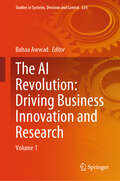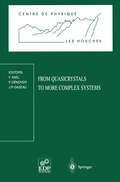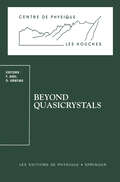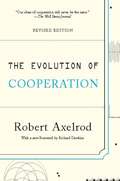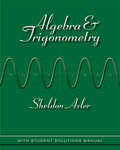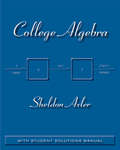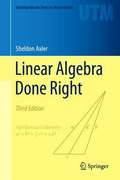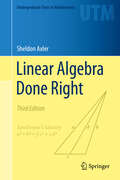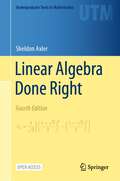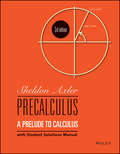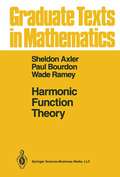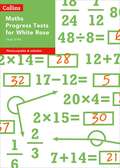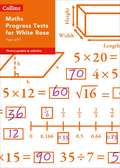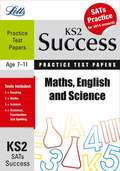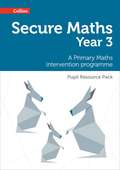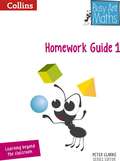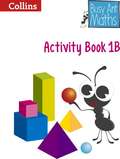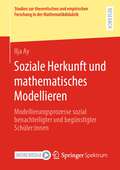- Table View
- List View
The AI Revolution: Volume 1 (Studies in Systems, Decision and Control #524)
by Bahaa AwwadThis comprehensive book explores the transformative role of artificial intelligence (AI) in business innovation and research. It provides a solid foundation in AI technologies, such as machine learning, natural language processing, and computer vision, and examines how they reshape business models and revolutionize industries. The book highlights the strategic implications of AI in enhancing customer experience, optimizing operations, and enabling data-driven decision-making. It explores the integration of AI with emerging trends like IoT, blockchain, and cloud computing for innovation. The role of AI in advancing scientific discovery and academic research is also explored, addressing challenges and opportunities in AI-driven methodologies. Organizational and ethical dimensions of AI implementation are considered, including talent acquisition, skills development, and data governance. Real-world case studies showcase AI's transformative power across diverse industries. This forward-thinking guide equips academics, researchers, and business leaders with knowledge and insights to harness the potential of AI and contribute to innovation and research.
From Quasicrystals to More Complex Systems: Les Houches School, February 23 – March 6, 1998 (Centre de Physique des Houches #13)
by F. Axel F. Denoyer J. P. GazeauThis book is a collection of part of the written versions of the Physics Courses given at the Winter School "Order, Chance and Risk: Aperiodic Phenomena from Solid State to Finance" held at the Les Houches Center for Physics, between February 23 and March 6, 1998. The School gathered lecturers and participants from all over the world. On a thematic level, the content of the school can be viewed both as a continuation (aperiodic phenomena in solid state physics) and an extension (mathematical aspects of fmance and economy) of the previous "Beyond Quasicrystals", also held at Les Houches, March 7-18 1994 and published in the same ·series. One of its important goals was to promote in-depth concrete scientific exchanges between theoretical physicists, experimental physicists and mathematicians on the one hand, and on the other hand practitioners of the economico-fmancial sphere and specialists of financial mathematics. Therefore, besides the mathematical tools and concepts at work in theoretical descriptions, relevant experimental data were also presented together with methods allowing their interpretation. As a result of this choice, the School was stimulated by experimentalists and fmancial market operators who joined the theoretical physicists and mathematicians at the conference. The present volume deals with the theoretical and experimental studies on aperiodic solids with long range order, incommensurate phases, quasicrystals, glasses, and more complex systems (fractal, chaotic), while a second volume to appear in the same series is devoted to the finance and economy facet.
Beyond Quasicrystals: Les Houches, March 7–18, 1994 (Centre de Physique des Houches #3)
by Françoise Axel Denis GratiasThis book is the collection of most of the written versions of the Courses given at the Winter School "Beyond Quasicrystals" in Les Houches (March 7-18, 1994). The School gathered lecturers and participants from all over the world and was prepared in the spirit of a general effort to promote theoretical and experimental interdisciplinary communication between mathematicians, theoretical and experimental physicists on the topic of the nature of geometric order in solids beyond standard periodicity and quasi periodicity. The overall structure of the book reflects the wish of the editors to pose this fundamental question of geometric order in solids from both the experimental and theoretical point of view. The first part is devoted more specifically to quasicrystals. These materials were the common starting point of most of the audience and present a first concrete example of a non-trivial geometric order. We chose to focus on a few fundamental aspects of quasicrystals related to hidden symmetries in solids which are not easily found in standard textbooks on the topic, not to reach an exhaustive survey which is already available elsewhere.
The Evolution of Cooperation: Revised Edition
by Robert AxelrodA famed political scientist's classic argument for a more cooperative worldWe assume that, in a world ruled by natural selection, selfishness pays. So why cooperate? In The Evolution of Cooperation, political scientist Robert Axelrod seeks to answer this question. In 1980, he organized the famed Computer Prisoners Dilemma Tournament, which sought to find the optimal strategy for survival in a particular game. Over and over, the simplest strategy, a cooperative program called Tit for Tat, shut out the competition. In other words, cooperation, not unfettered competition, turns out to be our best chance for survival.A vital book for leaders and decision makers, The Evolution of Cooperation reveals how cooperative principles help us think better about everything from military strategy, to political elections, to family dynamics.
Preconditioned Conjugate Gradient Methods: Proceedings of a Conference held in Nijmegen, The Netherlands, June 19-21, 1989 (Lecture Notes in Mathematics #1457)
by Owe Axelsson Lily Yu. KolotilinaComputational Methods for Representations of Groups and Algebras: Euroconference in Essen (Germany), April 1–5, 1977 (Progress in Mathematics #173)
by P. Äxler G. Michler C. M. RingelAlgebra and Trigonometry
by Sheldon AxlerAxler Algebra & Trigonometry is written for the two semester course. The text provides students with the skill and understanding needed for their coursework and for participating as an educated citizen in a complex society. Axler Algebra & Trigonometry focuses on depth, not breadth of topics by exploring necessary topics in greater detail. Readers will benefit from the straightforward definitions and plentiful examples of complex concepts. The Student Solutions Manual is integrated at the end of every section. The proximity of the solutions encourages students to go back and read the main text as they are working through the problems and exercises. The inclusion of the manual also saves students money. Axler Algebra & Trigonometry is available with WileyPLUS; an innovative, research-based, online environment for effective teaching and learning. WileyPLUS sold separately from text.
College Algebra
by Sheldon AxlerCollege Algebra, First Edition will appeal to those who want to give important topics more in-depth, higher-level coverage. This text offers streamlined approach accompanied with accessible definitions across all chapters to allow for an easy-to-understand read. College Algebra contains prose that is precise, accurate, and easy to read, with straightforward definitions of even the topics that are typically most difficult for students.
Linear Algebra Done Right (Undergraduate Texts In Mathematics Ser. (PDF))
by Sheldon AxlerThis best-selling textbook for a second course in linear algebra is aimed at undergrad math majors and graduate students. The novel approach taken here banishes determinants to the end of the book. The text focuses on the central goal of linear algebra: understanding the structure of linear operators on finite-dimensional vector spaces. The author has taken unusual care to motivate concepts and to simplify proofs. A variety of interesting exercises in each chapter helps students understand and manipulate the objects of linear algebra. The third edition contains major improvements and revisions throughout the book. More than 300 new exercises have been added since the previous edition. Many new examples have been added to illustrate the key ideas of linear algebra. New topics covered in the book include product spaces, quotient spaces, and dual spaces. Beautiful new formatting creates pages with an unusually pleasant appearance in both print and electronic versions. No prerequisites are assumed other than the usual demand for suitable mathematical maturity. Thus the text starts by discussing vector spaces, linear independence, span, basis, and dimension. The book then deals with linear maps, eigenvalues, and eigenvectors. Inner-product spaces are introduced, leading to the finite-dimensional spectral theorem and its consequences. Generalized eigenvectors are then used to provide insight into the structure of a linear operator.
Linear Algebra Done Right (Undergraduate Texts in Mathematics)
by Sheldon AxlerThis best-selling textbook for a second course in linear algebra is aimed at undergrad math majors and graduate students. The novel approach taken here banishes determinants to the end of the book. The text focuses on the central goal of linear algebra: understanding the structure of linear operators on finite-dimensional vector spaces. The author has taken unusual care to motivate concepts and to simplify proofs. A variety of interesting exercises in each chapter helps students understand and manipulate the objects of linear algebra.The third edition contains major improvements and revisions throughout the book. More than 300 new exercises have been added since the previous edition. Many new examples have been added to illustrate the key ideas of linear algebra. New topics covered in the book include product spaces, quotient spaces, and dual spaces. Beautiful new formatting creates pages with an unusually pleasant appearance in both print and electronic versions.No prerequisites are assumed other than the usual demand for suitable mathematical maturity. Thus the text starts by discussing vector spaces, linear independence, span, basis, and dimension. The book then deals with linear maps, eigenvalues, and eigenvectors. Inner-product spaces are introduced, leading to the finite-dimensional spectral theorem and its consequences. Generalized eigenvectors are then used to provide insight into the structure of a linear operator.
Linear Algebra Done Right (Undergraduate Texts in Mathematics)
by Sheldon AxlerNow available in Open Access, this best-selling textbook for a second course in linear algebra is aimed at undergraduate math majors and graduate students. The fourth edition gives an expanded treatment of the singular value decomposition and its consequences. It includes a new chapter on multilinear algebra, treating bilinear forms, quadratic forms, tensor products, and an approach to determinants via alternating multilinear forms. This new edition also increases the use of the minimal polynomial to provide cleaner proofs of multiple results. Also, over 250 new exercises have been added.The novel approach taken here banishes determinants to the end of the book. The text focuses on the central goal of linear algebra: understanding the structure of linear operators on finite-dimensional vector spaces. The author has taken unusual care to motivate concepts and simplify proofs. A variety of interesting exercises in each chapter helps students understand and manipulate the objects of linear algebra. Beautiful formatting creates pages with an unusually student-friendly appearance in both print and electronic versions. No prerequisites are assumed other than the usual demand for suitable mathematical maturity. The text starts by discussing vector spaces, linear independence, span, basis, and dimension. The book then deals with linear maps, eigenvalues, and eigenvectors. Inner-product spaces are introduced, leading to the finite-dimensional spectral theorem and its consequences. Generalized eigenvectors are then used to provide insight into the structure of a linear operator.From the reviews of previous editions:Altogether, the text is a didactic masterpiece. — zbMATHThe determinant-free proofs are elegant and intuitive. — American Mathematical MonthlyThe most original linear algebra book to appear in years, it certainly belongs in every undergraduate library — CHOICE
Measure, Integration & Real Analysis (Graduate Texts in Mathematics #282)
by Sheldon AxlerThis open access textbook welcomes students into the fundamental theory of measure, integration, and real analysis. Focusing on an accessible approach, Axler lays the foundations for further study by promoting a deep understanding of key results. Content is carefully curated to suit a single course, or two-semester sequence of courses, creating a versatile entry point for graduate studies in all areas of pure and applied mathematics.Motivated by a brief review of Riemann integration and its deficiencies, the text begins by immersing students in the concepts of measure and integration. Lebesgue measure and abstract measures are developed together, with each providing key insight into the main ideas of the other approach. Lebesgue integration links into results such as the Lebesgue Differentiation Theorem. The development of products of abstract measures leads to Lebesgue measure on Rn.Chapters on Banach spaces, Lp spaces, and Hilbert spaces showcase major results such as the Hahn–Banach Theorem, Hölder’s Inequality, and the Riesz Representation Theorem. An in-depth study of linear maps on Hilbert spaces culminates in the Spectral Theorem and Singular Value Decomposition for compact operators, with an optional interlude in real and complex measures. Building on the Hilbert space material, a chapter on Fourier analysis provides an invaluable introduction to Fourier series and the Fourier transform. The final chapter offers a taste of probability.Extensively class tested at multiple universities and written by an award-winning mathematical expositor, Measure, Integration & Real Analysis is an ideal resource for students at the start of their journey into graduate mathematics. A prerequisite of elementary undergraduate real analysis is assumed; students and instructors looking to reinforce these ideas will appreciate the electronic Supplement for Measure, Integration & Real Analysis that is freely available online.
Precalculus: A Prelude to Calculus
by Sheldon AxlerSheldon Axler's Precalculus: A Prelude to Calculus, 3rd Edition focuses only on topics that students actually need to succeed in calculus. This book is geared towards courses with intermediate algebra prerequisites and it does not assume that students remember any trigonometry. It covers topics such as inverse functions, logarithms, half-life and exponential growth, area, e, the exponential function, the natural logarithm and trigonometry.
Harmonic Function Theory (Graduate Texts in Mathematics #137)
by Sheldon Axler Paul Bourdon Wade RameyHarmonic functions - the solutions of Laplace's equation - play a crucial role in many areas of mathematics, physics, and engineering. Avoiding the disorganization and inconsistent notation of other expositions, the authors approach the field from a more function-theoretic perspective, emphasizing techniques and results that will seem natural to mathematicians comfortable with complex function theory and harmonic analysis; prerequisites for the book are a solid foundation in real and complex analysis together with some basic results from functional analysis. Topics covered include: basic properties of harmonic functions defined on subsets of Rn, including Poisson integrals; properties bounded functions and positive functions, including Liouville's and Cauchy's theorems; the Kelvin transform; Spherical harmonics; hp theory on the unit ball and on half-spaces; harmonic Bergman spaces; the decomposition theorem; Laurent expansions and classification of isolated singularities; and boundary behavior. An appendix describes routines for use with MATHEMATICA to manipulate some of the expressions that arise in the study of harmonic functions.
Harmonic Function Theory (Graduate Texts in Mathematics #137)
by Sheldon Axler Paul Bourdon Ramey WadeThis book is about harmonic functions in Euclidean space. This new edition contains a completely rewritten chapter on spherical harmonics, a new section on extensions of Bochers Theorem, new exercises and proofs, as well as revisions throughout to improve the text. A unique software package supplements the text for readers who wish to explore harmonic function theory on a computer.
A Glimpse at Hilbert Space Operators: Paul R. Halmos in Memoriam (Operator Theory: Advances and Applications #207)
by Sheldon Axler Peter Rosenthal Donald SarasonPaul Richard Halmos, who lived a life of unbounded devotion to mathematics and to the mathematical community, died at the age of 90 on October 2, 2006. This volume is a memorial to Paul by operator theorists he inspired. Paul’sinitial research,beginning with his 1938Ph.D. thesis at the University of Illinois under Joseph Doob, was in probability, ergodic theory, and measure theory. A shift occurred in the 1950s when Paul’s interest in foundations led him to invent a subject he termed algebraic logic, resulting in a succession of papers on that subject appearing between 1954 and 1961, and the book Algebraic Logic, published in 1962. Paul’s ?rst two papers in pure operator theory appeared in 1950. After 1960 Paul’s research focused on Hilbert space operators, a subject he viewed as enc- passing ?nite-dimensional linear algebra. Beyond his research, Paul contributed to mathematics and to its community in manifold ways: as a renowned expositor, as an innovative teacher, as a tireless editor, and through unstinting service to the American Mathematical Society and to the Mathematical Association of America. Much of Paul’s in?uence ?owed at a personal level. Paul had a genuine, uncalculating interest in people; he developed an enormous number of friendships over the years, both with mathematicians and with nonmathematicians. Many of his mathematical friends, including the editors ofthisvolume,whileabsorbingabundantquantitiesofmathematicsatPaul’sknee, learned from his advice and his example what it means to be a mathematician.
Cognitive Neuroscience of Memory Consolidation (Studies in Neuroscience, Psychology and Behavioral Economics)
by Nikolai Axmacher Björn RaschThis edited volume provides an overview the state-of-the-art in the field of cognitive neuroscience of memory consolidation. In a number of sections, the editors collect contributions of leading researchers . The topical focus lies on current issues of interest such as memory consolidation including working and long-term memory. In particular, the role of sleep in relation to memory consolidation will be addressed. The target audience primarily comprises research experts in the field of cognitive neuroscience but the book may also be beneficial for graduate students.
Maths Progress Tests for White Rose Year 5/P6 (PDF)
by Rachel Axten-HiggsCheck pupils are on track and making expected progress in Year 5 maths with 12 tests per year (6 arithmetic and 6 reasoning tests) which follow the Primary White Rose Schemes of Learning. Photocopiable and editable, these informal tests help identify gaps in learning and next steps. Assess pupils’ arithmetic and reasoning skills in Year 5 with questions that use the latest SATs style language to help build familiarity and confidence for the KS2 maths tests. Measure progress every half term with tests that follow the White Rose Small Steps. Check pupils are on track for the expected standard with guidance and clear SATs style mark schemes. Easy to use with national curriculum objectives and content domain references in a yearly overview. Save time with high quality tests written by primary maths experts and with a free editable download so you can adapt for your school. Available for Years 1–6/P2–P7, you can provide a consistent and systematic way of assessing maths in your school.
Maths Progress Tests for White Rose Year 6/P7 (PDF)
by Rachel Axten-HiggsCheck pupils are on track and making expected progress in Year 6 maths with 12 tests per year (6 arithmetic and 6 reasoning tests) which follow the Primary White Rose Schemes of Learning. Photocopiable and editable, these informal tests help identify gaps in learning and next steps. Assess pupils’ arithmetic and reasoning skills in Year 3 with questions that use the latest SATs style language to help build familiarity and confidence for the KS2 maths tests. Measure progress every half term with tests that follow the White Rose Small Steps. Check pupils are on track for the expected standard with guidance and clear SATs style mark schemes. Easy to use with national curriculum objectives and content domain references in a yearly overview. Save time with high quality tests written by primary maths experts and with a free editable download so you can adapt for your school. Available for Years 1–6/P2–P7, you can provide a consistent and systematic way of assessing maths in your school.
Maths, English and Science: Practice Test Papers (PDF)
by Rachel Axten-Higgs Jackie Clegg Jason White Jon Goulding Bob McduellThis book of Maths, English amp; Science Test Papers provides realistic test practice for the National Tests (SATs) that pupils take in Year 6. It contains multiple papers so that children can familiarise themselves with the content and style of the actual tests, plus answers, mark scheme and notes for parents. Focussed assessment preparation is provided in realistic test papers.
Secure Maths - Year 3: A Primary Maths Intervention Programme Pupil Resource Pack (Secure Maths Ser.)
by Rachel Axten-Higgs Paul HodgeSecure Maths - Year 3: A Primary Maths Intervention Programme Pupil Resource Pack
Busy Ant Maths: Homework Guide 1 (PDF)
by Rachel Axten-Higgs Nicola Morgan Jo PowerThe Busy Ant Maths programme ensures conceptual understanding and mathematical fluency from the start inside and outside the classroom.
Busy Ant Maths: Year 1 Activity Book 1B (PDF)
by Rachel Axten-Higgs Jo PowerUsed in conjunction with the Teacher's Guide, Progress Guide and Homework Guide, the Busy Ant Maths Pupil Book 1B is the best way to ensure that pupils achieve all the learning objectives of the new Primary Maths National Curriculum.
Motion and Genetic Definitions in the Sixteenth-Century Euclidean Tradition (Frontiers in the History of Science)
by Angela AxworthyA significant number of works have set forth, over the past decades, the emphasis laid by seventeenth-century mathematicians and philosophers on motion and kinematic notions in geometry. These works demonstrated the crucial role attributed in this context to genetic definitions, which state the mode of generation of geometrical objects instead of their essential properties. While the growing importance of genetic definitions in sixteenth-century commentaries on Euclid’s Elements has been underlined, the place, uses and status of motion in this geometrical tradition has however never been thoroughly and comprehensively studied. This book therefore undertakes to fill a gap in the history of early modern geometry and philosophy of mathematics by investigating the different treatments of motion and genetic definitions by seven major sixteenth-century commentators on Euclid’s Elements, from Oronce Fine (1494–1555) to Christoph Clavius (1538–1612), including Jacques Peletier (1517–1582), John Dee (1527–1608/1609) and Henry Billingsley (d. 1606), among others. By investigating the ontological and epistemological conceptions underlying the introduction and uses of kinematic notions in their interpretation of Euclidean geometry, this study displays the richness of the conceptual framework, philosophical and mathematical, inherent to the sixteenth-century Euclidean tradition and shows how it contributed to a more generalised acceptance and promotion of kinematic approaches to geometry in the early modern period.
Soziale Herkunft und mathematisches Modellieren: Modellierungsprozesse sozial benachteiligter und begünstigter Schüler:innen (Studien zur theoretischen und empirischen Forschung in der Mathematikdidaktik)
by Ilja AySoziale Ungleichheit im Bildungswesen stellt eine wesentliche Herausforderung moderner Gesellschaften dar. Zusammenhänge zwischen der sozialen Herkunft von Schüler:innen und ihrer Mathematikleistung können statistisch vielfach nachgewiesen werden. Ebenso legen zahlreiche Studien nahe, dass das System Schule dazu tendiert, die außerschulischen Handlungslogiken sozial benachteiligter Personen als defizitärer einzustufen. Gerade beim Umgang mit Modellierungsaufgaben, d.h. realitätsnahen und offenen Problemen, können die außerschulischen Logiken von Schüler:innen wirksam werden. Die Bedeutung mathematischen Modellierens für soziale Ungleichheit wird dabei in der Literatur kontrovers diskutiert. Diese qualitativ angelegte Forschungsstudie untersucht auf Grundlage von Bourdieus Konzepten Mechanismen sozialer Ungleichheit beim Modellieren aus einer bildungssoziologischen Perspektive, die die Verfügbarkeit von Ressourcen und die häusliche Sozialisation von Schüler:innen in den Blick nimmt. Diskutiert werden Auffälligkeiten, die sich beim Bearbeiten von Modellierungsaufgaben bei Schüler:innen unterschiedlicher sozialer Herkunft zeigen. Damit soll insgesamt ein Beitrag dazu geleistet werden, Herausforderungen und Potentiale mathematischen Modellierens für einen sozial gerechteren Unterricht zu diskutieren.
